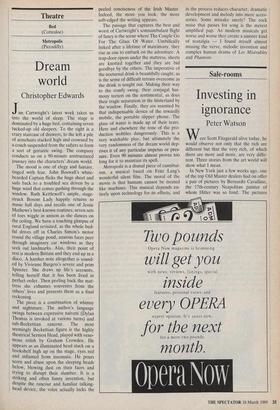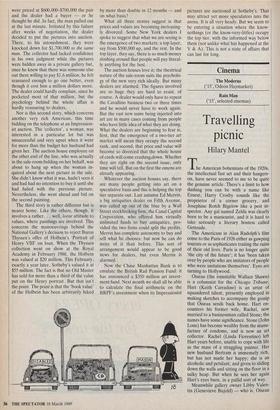Sale-rooms
Investing in ignorance
Peter Watson
Were Scott Fitzgerald alive today, he would observe not only that the rich are different but that the very rich, of which there are more and more, are very diffe- rent. Three stories from the art world will show what I mean.
In New York just a few weeks ago, one of the top Old Master dealers had on offer a pair of pictures by Bernardo Cavallino, the 17th-century Neapolitan painter of whom Hitler was so fond. The pictures
were priced at $600,000–$700,000 the pair and the dealer had a buyer — or he thought he did. In fact, the man pulled out at the last minute. Irritated by this failure after weeks of negotiation, the dealer decided to put the pictures into auction. There, to his astonishment, they were knocked down for $1,700.000 to the same man. The collector had lacked confidence in his own judgment while the pictures were hidden away in a private gallery but, once he knew that there was someone else out there willing to pay $1.6 million, he felt reassured enough to go one better, even though it cost him a million dollars more. The dealer could hardly complain, since he pocketed most of that million, but the psychology behind the whole affair is hardly reassuring to dealers.
Nor is this second story, which concerns another very rich American, this time bidding on the telephone at an Impression- ist auction. The 'collector', a woman, was interested in a particular lot but was unsuccessful and very upset when it went for more than the budget her husband had given her. The auction house employee on the other end of the line, who was actually in the sale-room bidding on her behalf, was about to hang up when the woman in- quired about the next picture in the sale. She didn't know what it was, hadn't seen it and had had no intention to buy it until she had failed with the previous picture. Nevertheless, she went ahead and bid on the second painting.
The third story is rather different but is nearer home. Like the others, though, it involves a rather. . . well, loose attitude to values, where paintings are involved. This concerns the manoeuvrings behind the National Gallery's decision to reject Baron Thyssen's offer of Holbein's 'Portrait of Henry VIII' on loan. When the Thyssen collection went on show at the Royal Academy in February 1988, the Holbein was valued at $20 million. This February, exactly a year later, Sotheby's valued it at $55 million. The fact is that no Old Master has sold for more than a third of the value put on the Henry portrait. But that isn't the point. The point is that the `book value' of the Holbein has been arbitrarily hiked
by more than double in 12 months — and on what basis?
What all three stories suggest is that prices and values are becoming increasing- ly divorced. Some New York dealers I spoke to suggest that what we are seeing is the emergence of two markets: a top layer, say from $500,000 up, and the rest. In the top layer, they say, there is so much money sloshing around that people will pay literal- ly anything for the best.
The auction houses love it; the theatrical nature of the sale-room suits the psycholo- gy of the new very rich ideally. But many dealers are alarmed. The figures involved are so huge they are hard to resist, of course. A dealer would only have to repeat the Cavallino business two or three times and he would never have to work again. But the vast new sums being injected into art are in many cases coming from people who have little idea of what they are doing. What the dealers are beginning to fear is, first, that the emergence of a two-tier art market will mean they occupy the second rank, and second, that price and value will become so divorced that the whole house of cards will come crashing,,clown. Whether they are right on the second issue, only time will tell. But on the first the omens are already appearing.
Whatever the auction houses say, there are many people getting into art on a speculative basis and this is helping the top tier separate out. Last autumn Ed Merrin, a big antiquities dealer on Fifth Avenue, was called up out of the blue by a Wall Street stockbroking firm, the Canal Capital Corporation, who offered him virtually unlimited funds to buy antiquities, pro- vided the two firms could split the profits. Merrin has complete autonomy to buy and sell what he chooses: but now he can do more of it than before. This sort of arrangement would appear to be good news for dealers, but even Merrin is alarmed.
Now the Chase Manhattan Bank is to emulate the British Rail Pension Fund: it has announced a $350 million art invest- ment fund. Next month we shall all be able to calculate the final arithmetic on the BRPF's investment when its Impressionist pictures are auctioned at Sotheby's. That may attract yet more speculators into the arena. It is all very heady. But we seem to be entering a situation where the know- nothings (or the know-very-littles) occupy the top tier, with the informed way below them (not unlike what has happened at the V & A). This is not a state of affairs that can last for long.



























































 Previous page
Previous page